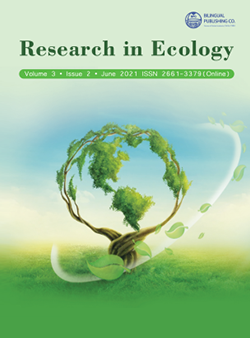
Diversity of Pigments in Insects, Their Synthesis and Economic Value for Various Industries
DOI:
https://doi.org/10.30564/re.v3i2.2899Abstract
Pigments play an essential role in imparting colors to the various organs of invertebrates particularly, insects. Genetic evolution and adaptive pigmentation of invertebrates have been studied which depicted that insect colors respond to the climatic changes. The physical, chemical and structural properties of insect pigments are being studied by researchers for years to elucidate their evolutionary aspects of physiology, metabolism, and economic importance for human welfare. Color development in insects varies within the species of different genera. In this state-of-the-art literature review, we discuss the variety of pigments other than visual ones found in different species of insects. The review also highlights the potential benefits or functions of pigments to insects.
Keywords:
Pigment; Colour development; Insect; Genetics; Commercial valueReferences
[1] Alcock J. (1998) Animal behavior: an evolutionary approach., 6th ed. Sunderland, MA: Sinauer Associates, Inc.
[2] French V. (1997) Pattern formation in colour of butterfly wings. Current Opinion in Genetics and development,7: 524-529.
[3] Cromartie R.I.T. (1959) Insect Pigments. Annual Review of Entomology 4: 59-76. DOI: https://doi.org/10.1146/annurev.en.04.010159.000423.
[4] Wittkopp P.J. and Beldade P. (2009) Development and evolution of insect pigmentation: Genetic mechanisms and the potential consequences of pleiotrophy. Review seminars in cell and development biology 20: 65-711. DOI: https://doi.org/10.1016/j.semcdb.2008.10.002.
[5] Gulsaz S., Ranjan S.K., Pandey D.M. and Ranganathan R. (2014) Biochemistry and biosynthesis of insect pigments. Eur. J. Entomol. 111: 149-164. DOI: https://doi.org/10.14411/eje.2014.021.
[6] Mollon J.D. and Sharpe L.T (1983). Colour Vision: Academic Press (eds.), London.
[7] Hoekstra H.E. (2006). Genetics, development and evolution of adaptive pigmentation in vertebrates. Heredity, 97: 222-234. DOI: https://doi.org/10.1038/sj.hdy.6800861.
[8] Mason K.A, Mason S.K.F. (2000) Evolution and development of pigment cells: at the crossroads of the discipline. Pigment Cell Research 13 (s8): 150-155. DOI: https://doi.org/10.1034/j.1600-0749.13.s8.27.x.
[9] Briscoe A.D., Chittka L. (2001) The evolution of colour vision in insects. Annual review of entomology 46: 471-510.
[10] Brakefield P.M and French V. (1999) Butterfly wings: the evolution of development of colour patterns. BioEssays 21: 391-40.
[11] Badejo O., Skaldina O., Gilev A and Sorvari J. (2020). Benefits of insect colours-a review from social insect studies. Oecologia194: 27-40. DOI: https://doi.org/10.1007/s00442-020-04738-1.
[12] Insausti T.C., Le Gall M., Lazzari C.R. (2013) Oxidative stress, photo damage and the role of screening pigments in insect eyes. J. Exp. Biol. 216: 3200-07. DOI: https://doi.org/10.1242/jeb.082818.
[13] Stavenga D.G. (2013). Colour in the eyes of insects. IUBMB Life 65: 334-340. DOI: https://doi.org/10.1002/iub.1145.
[14] Heath J.J., Cipollini D., Stireman III J.O. (2013) The role of Carotenoids and their derivatives in mediating interactions between insects and their environment. Arthropod-Plant Interactions 7: 1-20. DOI: https://doi.org/10.1007/s11829-012-9239-7.
[15] Chapman R.F. (1998) Insect Structure and function. 4th Edn. Chapter 25,657-671.
[16] Okude G. and Futahashi. R. (2021) Pigmentation and color pattern diversity in Odonata. Current Opinion in Genetics and development 69: 14-20.
[17] Futahashi R., Kurita R., Mano H., Fukatsu T. (2012) Redox alters yellow dragonflies into red. Proc. Natl. Acad. Sci. USA 109: 12626-12631. DOI: https://dx.doi.org/10.1073%2Fpnas.1207114109.
[18] Hackman R.H. (1952) Green pigments of the hemolymph of insects. Archives of Biochemistry and Biophysics 14:166-174. DOI: https://doi.org/10.1016/0003-9861(52)90517.
[19] Onelli D.O., Kamp V.T., Skepper N.J., Powell J., Santosrolo D.T., Baumbach T. and Vignolini, S. (2017) Development of structural colour in leaf beetles. Scientific Reports 7: 1373. DOI: https://doi.org/10.1038/s41598-017-01496-8.
[20] Martins G.F., Serrão J.E., Ramalho-Ortigão J.M., Pimenta P.F. (2011) A comparative study of fat body morphology in five mosquito species. Mem Inst Oswaldo Cruz. 106(6): 742-747. DOI: https://doi.org/10.1590/s0074-02762011000600015.
[21] Gustavo F.M., Serrao J.E, Ramalho-Ortigao J.M, Filemon P, Paolucci P. (2011) A comparative study of fat body morphology in five mosquito species) MEM Inst Oswaldo Cruz, Rio De Janeiro 106(6): 742-747. DOI: https://doi.org/10.1590/S0074-02762011000600015.
[22] CAO, W., XUHAO Z., NANEKI C.M.C., ZIYING HU, ZHE N.Q., UTKARSH K., CHRISTIAN M.H., KRISTINE S.C., TARA Z., ALEX J.M., ARTHI J. (2021) UNRAVELING THE STRUCTURE AND FUNCTION OF MELANIN THROUGH SYNTHESIS. J. AMERICAN CHEMICAL SOCIETY. DOI: https://doi.org/10.1021/JACS.0C12322.
[23] Hackman R.H. (1967) Melanin in an insect, Lucilia cuprina. (Wied.). Nature, 163. DOI: https://doi.org/10.1038/216163a.
[24] Osanai-Futahashi M., Ohde T., Hirata J., Uchino K., Futahashi R., Tamura T., Niimi T., and Sezutsu, H. (2015) A visible dominant marker for insect transgenesis. Nature Communications 3. DOI: https://doi.org/10.1038/ncomms2312.
[25] Meir P.P. and Stephen J.S. (2009) Locust phase polyphenism: an update. Advances in insect Physiology, 36:57.
[26] Osanai-Futahashi,M. Tatematsu K., Yamamoto K., Narukawa J.,Uchino K., Kayukawa T., Shinoda T., Banno Y., Tamura T., Sezutsu H. (2012) Identification of the Bombyx red egg gene reveals the involvement of a novel transporter family gene in the late steps of the insect ommochrome biosynthesis pathway. J Biol Chem. 287: 17706-14. DOI: https://doi.org/10.1074/jbc.M111.321331.
[27] Tanaka S. and Paulpener M. (1994). A neuropeptide controlling the dark pigmentation in colour polymorphism of the migratory locust, Locusta migratoria. Journal of Insect Physiology 40: 997-1005. DOI: https://doi.org/10.1016/0022-1910(94)90138-4.
[28] Tanaka S. (2006). Corazonin and locust phase polyphenism. Applied Entomology and Zoology 41:179- 193. DOI: https://doi.org/10.1303/aez.2006.179.
[29] Allevi P., Tyman A. (1998) Synthesis of carminic acid, the colourant principle of cochineal. J. Chem. Soc. Perkin Trans.1: 575-582.
[30] Greenfield A.B. (2005) A perfect red: empire, espionage and quest for the colour of desire. Doubleday, Transworld Publication, UK.
[31] Gooch J.W. (2011) Shellac. encyclopedic dictionary of polymers. 2nd Edn. Springer, 658 659.
Downloads
How to Cite
Issue
Article Type
License
Copyright © 2021 Author(s)

This is an open access article under the Creative Commons Attribution-NonCommercial 4.0 International (CC BY-NC 4.0) License.




 Tanuja N. Bankar
Tanuja N. Bankar





